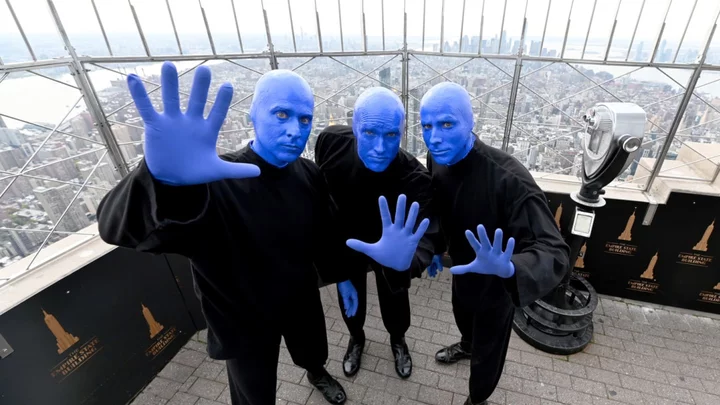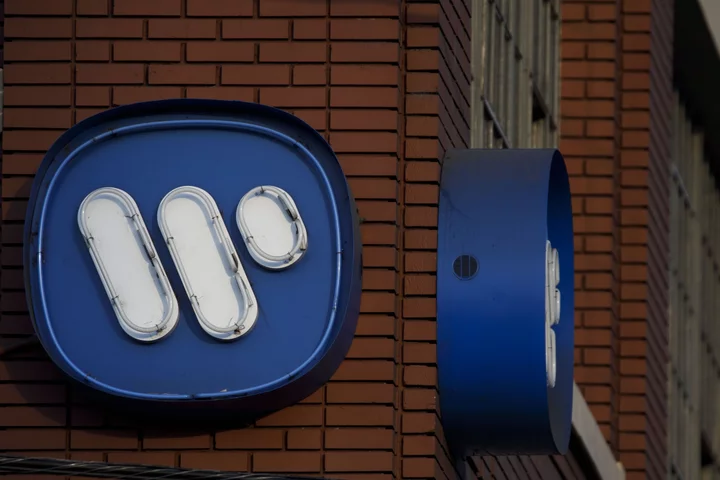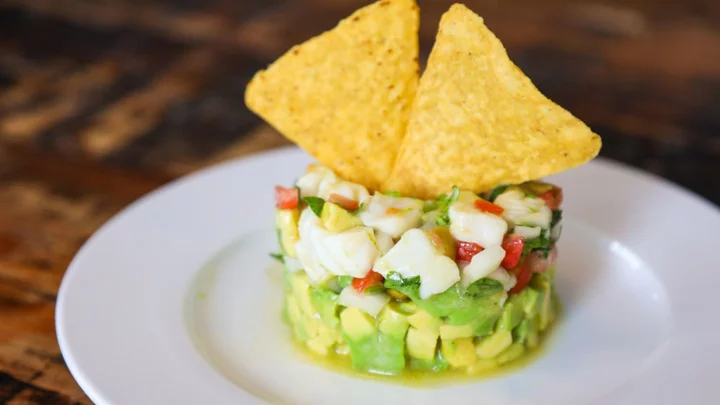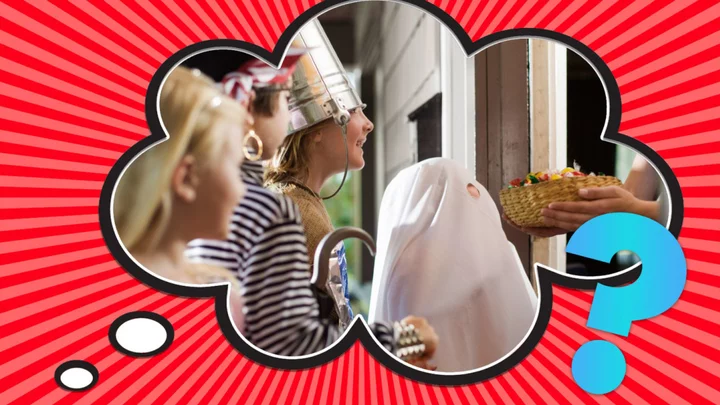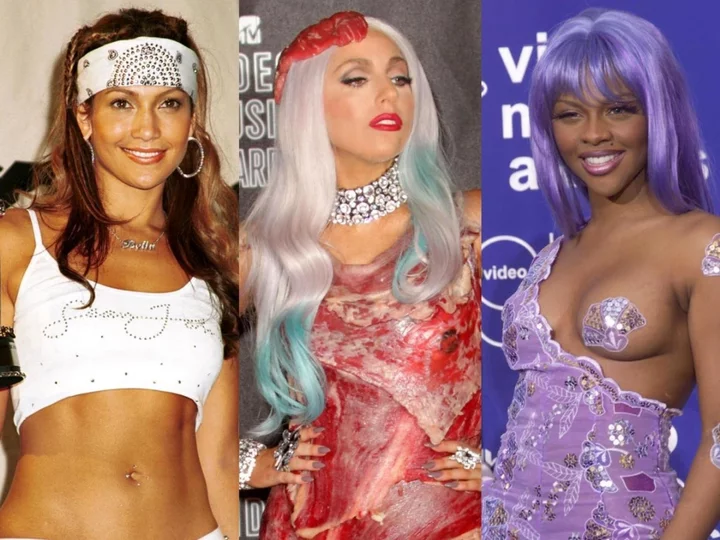In 1988, MTV covered a funeral. It was not for any recently departed rock star, but for the decade itself—a solemn procession held in Central Park that included a Rambo doll being set ablaze, all to bid goodbye to the excess of the era.
If that weren’t indication enough that the services were biting and satirical, one look at the “mourners” would be: All nine of them were painted blue.
When the footage aired on the channel, it was probably dismissed as MTV—which was known for embracing the counterculture—covering a peculiar piece of performance art. Instead, it turned out to be the emergence of an entertainment franchise based on the childlike curiosity of three mute, earless artists who met at the intersection of avant-garde and the mainstream: Blue Man Group.
Blue Man Beginnings
Chris Wink and Matt Goldman, friends since grade school, spent time in the mid-1980s thinking about how to explore modernism and technology in performance. The decade was giving way to personal computers and increasingly sophisticated gadgets. In response to the ever-growing anxiety around technology, they conjured up characters who were eager to learn and discover the tactile world around them. Their friend Phil Stanton joined in 1986, and the trio imagined a show that would capture the feeling of a painting come to life, full of vibrant colors and pantomime. The result was Blue Man Group, consisting of three Blue Men, each of whom had (and have) a very defined persona.
“The Blue Man is part innocent, hero, scientist, shaman, group member, and trickster,” Goldman told Inc. in 2008. “He doesn't speak, but he communicates with vaudevillian slapstick humor. He drums and catches gumballs in his mouth that are filled with paint, which he spits onto a canvas to make art. It's interactive, with music, lights, and lots of colorful liquids that get sprayed on the stage and into the audience.”
That there were three of them was no accident. Though friends had joined them for the Central Park performance, the core was a trio. “Three is the smallest unit where you can have an outsider; two guys win the third over, or the third guy wins the two guys in,” Goldman said. “It can go either way, and that tension makes for good theater. It also makes for good business partners—it takes the ego out of it.”
For the next few years, Wink, Goldman, and Stanton stretched bald caps over their heads and ears and slathered themselves in cobalt blue greasepaint. Though they weren’t always silent at first, Wink later said being mute seemed to feel right. Some of their pieces required no commercial space. They once set up a velvet rope outside the popular Copacabana nightclub and invited people “in” to dance for free on the sidewalk.
In December 1990, the Blue Men went full-time, taking to stages that were open to amateurs and unproven acts, not unlike an open-mic night at a comedy club. It was Andy Warhol meets Double Dare: They made unique musical instruments out of PVC with names like tubulum and drumulum; they smashed into drums covered in paint and watched the spatter fly in all directions; they muted any expressions. Everything seemed to be astonishing to them, as though they were seeing it for the first time. Shows could even end with the audience covered in toilet paper.
Gigs in hip experimental spaces like P.S. 122 and La MaMa followed. Then, in 1991, the threesome received some financial backing from an investor and the chance to occupy space at the roughly 300-seat Astor Place Theater. They invited spectators up on stage and played with iconography like Twinkies, Cap’n Crunch, and Jell-O. While not quite Broadway, it was a huge step up from the random theater engagements and gave them a chance for more widespread recognition.
It worked. “With original music, deadpan sophistication and the biggest mess since the cafeteria scene in Animal House, Blue Man reduces the late 20th century to a post-modern romp in a lunatic nursery school,” wrote Vicki Goldberg in The New York Times. Dustin Hoffman escorted his son to the show and came away impressed. Bruce Willis and Demi Moore took them out for dinner. The trio also made appearances on The Tonight Show With Jay Leno. Attendance grew, and other cities like Boston and Chicago beckoned. But was it possible to franchise a radical sensibility?
Counter-Counterculture
In their Astor Place habitat, Blue Man Group performed an astonishing 1285 consecutive shows without a cancellation or substitution. But, as Goldman recalled, “We realized that if we wanted to grow, we’d have to replicate ourselves.”
Other performers were recruited from colleges, theaters, and even in drumming circles. Six months of training in how to walk, respond, and perform would help them prepare for their roles. A Boston show with their clones did well enough to migrate to Chicago. When that turned into a hit, the group’s friends, magicians Penn Jillette and Teller—the latter of whom is, curiously, also silent when on stage—encouraged them to set up shop in the mecca of live entertainment: Las Vegas.
It was not a runaway success. When the show opened in 2000, attendance was around 50 percent of capacity for 10 shows a week. Blue Man Group needed another push. But while the founders were willing to duplicate themselves, they were still wary of existing in a space other than the stage. They turned down opportunities to endorse M&M's and to appear in movies, all projects that could raise their profile.
One offer, however, made sense to them. Computer chip maker Intel wanted to enlist the group to endorse their new line of Pentium processors and were willing to let them have approval over the ad campaign.
In a series of spots, which the three treated like 30-second performance art pieces, Blue Man Group was able to achieve maximum exposure without sacrificing the inherent idea. Intel bought so much air time that it was considered one of the biggest ad pushes ever. More importantly, the three insisted that the ads have a Blue Man Group watermark onscreen so viewers wouldn’t think they were simply Intel mascots.
It all worked: Attendance for the Blue Man Group shows in Vegas shot up to 100 percent, even when they added four new shows per week.
The show moved to the Venetian Resort Hotel and Casino in 2005. By 2010, Goldman sold his one-third share to focus more on the Blue School, a private learning institution in New York that embraces creativity. (And where, one expects, some future Blue Men could be sourced.)
In 2017, the founders sold to Cirque du Soleil for a sum reputed to be in the tens of millions. “We started to feel like we needed some help, plus we had some creative ideas that were beyond our own means,” Wink said. “We thought of some ways that the Blue Men and their performances could go on a bigger scale.”
But that scale began to shrink. After the coronavirus pandemic halted live events in 2020, Cirque filed for bankruptcy protection; the business had to slowly regroup. The shows continue today, albeit without Wink, Stanton, or Goldman in blue paint. Roughly 50 million people worldwide have seen the show.
All of it brings the Blue Man Group full circle, but it also begs the question: Can a massive show employing hundreds of people and generating hundreds of millions in revenue be counterculture art, or is it now simply culture?
“What’s the difference between art and a Twinkie?” Wink said in 2001. “Blue Man spurts colors, and it becomes art or waste, depending on where it lands. If, by art, you mean something simple and available to everybody that’s not a big deal, then yes, we’re art. But if you mean is it important and elitist, we’d rather be known as comedians.”
Related Tags
ART TECHNOLOGY ENTERTAINMENT THEATER SPACE SCHOOL MUSIC CULTURE Pop Culture FRIENDS Home / TBT
